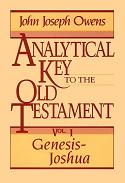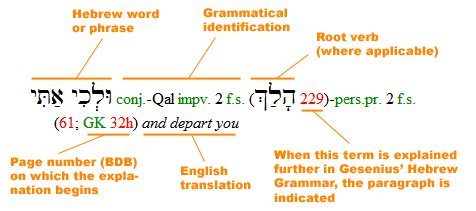 Analytical
Key to the Old Testament (4 vols.)
Analytical
Key to the Old Testament (4 vols.)
Biblia Hebraica Stuttgartensia,
Brown-Driver-Briggs Lexicon, and Gesenius' Grammar inside too!
by John Joseph Owens
Keyed to the Brown, Driver, and Briggs lexicon and Gesenius' Grammar this
classic reference work translates and identifies the words and phrases of
the Hebrew Bible for students of Hebrew. (Both BDB and the Gesenius Grammar
are available in the Libronix DLS format. If you have them installed, the
links in the Analytical Key to the Old Testament will be live
hyperlinks.)
'The single most valuable Hebrew reference tool available to the pastor
who has received some instruction in biblical Hebrew.' --Robert B.
Chisholm, Jr. (Bibliotheca Sacra)
You get all four of these new Baker titles for one low price.
- John Joseph Owens Analytical Key to the Old Testament Volume 1
Genesis-Joshua ($75.00 Hardcover)
- John Joseph Owens Analytical Key to the Old Testament Volume 2
Judges-Chronicles ($75.00 Hardcover)
- John Joseph Owens Analytical Key to the Old Testament Volume 3
Ezra-Song of Solomon ($75.00 Hardcover)
- John Joseph Owens Analytical Key to the Old Testament Volume 4
Isaiah-Malachi ($75.00 Hardcover)
From the Preface
Translation is the art of transferring the thoughts expressed in one
language and culture to the syntax, style, and words of a different language
and culture. Much more is involved than the simple replacement of one Hebrew
word with an English word. Even though there are many excellent translations,
the original text and/or a translation must be interpreted for an
understanding of the form, style, nuance, and context of the author. This
analytical key seeks to provide the basic elements necessary for valid
interpretation. Since it is very difficult to transfer one linguistic,
sociological, religious context into a completely different milieu, it is
imperative to examine the specific "building blocks" of the original writing
in order to establish distinct boundaries of meaning.
This key is intended to assist the person who knows some Hebrew but has not
retained interpretive or grammatical discernment. The user of this volume
must supplement this information with his/her own interpretive skill. For
instance, the use of a Hiph’il form when a Qal form is available is an
important nuance. Since there are no such things as absolute synonyms, one
must be alert to the specific grammatical structures utilized in the text.
It is the task of students, pastors, and theologians to interpret the
biblical text for untrained readers. From a translation, one cannot be
positive that the innuendos of the Hebrew text are properly understood. The
interpreter should be alert to such things as the verbal structures, the
presence or absence of the definite article, the construct relationships as
distinguished from the adjectival construction, and the waw conjunctives and/or
consecutives.
Since the conjunction as prefixed to an imperfect may take two different
written forms, this phenomenon is regularly noted (the simple conjunction is
noted as "conj." and the more complex form as "consec.").
Scholars disagree about the conjunction prefixed to a perfect. In earlier
times, some interpreters reasoned that if the imperfect had two forms of a
conjunction, it is only logical that the perfect could have two forms.
However, the biblical text uses only one form for the conjunction. Therefore,
this volume identifies the conjunction + perfect as "conj." It is the task
of the interpreter to ascertain the syntax and meaning of these grammatical
facts.
This key seeks to provide complete grammatical and lexicographical
information for each word of the entire canon. Each form has been identified.
The presence of definite articles, prepositions, and conjunctions is noted.
Nouns are clearly explained as to ticles, prepositions, and conjunctions is
noted. Nouns are clearly explained as to usage and relationship. Each
grammatical explanation provides the reader with information that must be
used in defining the various shades of meaning.
Accuracy has been attempted throughout in such forms as construct
relationships. Any noun with a pronominal suffix forms a construct
relationship. A pronominal suffix with a verb forms a verb/direct object
construction. No special note is taken of these.
The use of nouns/substantives/adjectives with the construct usage is
indicated. Also, the definite article has been indicated only when it is
grammatically present. Many translators have inserted or omitted articles
due to linguistic considerations. Since it is the biblical text which is the
object of interpretation, it is important to know what the original writers
used or did not use.
This volume provides for each word the page number of the standard
Hebrew-English dictionary (Francis Brown, S. R. Driver, and Charles A.
Briggs, A Hebrew and English Lexicon of the Old Testament [Oxford: Clarendon,
1975]) on which that word’s explanation begins.
This volume follows the Hebrew text chapter/verse by chapter/verse. Upon
finding the desired chapter/verse, the reader can locate the term desired by
following the Hebrew text at the left of the column.
The Hebrew text is the best complete Ben Asher text available (K. Ellinger
and W. Rudolph, eds., Biblia Hebraica Stuttgartensia [Stuttgart:
Wurttembergische Bibelanstalt, 1977]). When there has been an insoluble
difficulty in the text, a variant reading may be provided from better
translations or grammars.
If the student has difficulty in following the biblical Hebrew text, he/she
can identify the desired form from the English translation provided at the
conclusion of each entry. Generally, the English translation will follow the
Revised Standard Version. However, at times there will be a more literal
translation to assist in identifying the elements of the Hebrew text.

Figure 1.1 — The various components that may
appear in a given entry from AKOT. Colored text denotes Libronix DLS "hotspots"
with additional information available by clicking or hovering the mouse.
Screenshots
Click a thumbnail to see the full size version.

Libronix DLS makes it easy to set up the time-saving workspace shown here.
BHS and AKOT scroll synchronously; clicking a link in AKOT jumps BDB or
Gesenius' Grammar directly to the entry you need!

Hotspot links in AKOT can also be previewed by hovering the mouse. In
this example, a temporary pop-up window shows the relevant entry from
Gesenius's Grammar.
| Стоимость CD-ROM: 20 у.е. |


